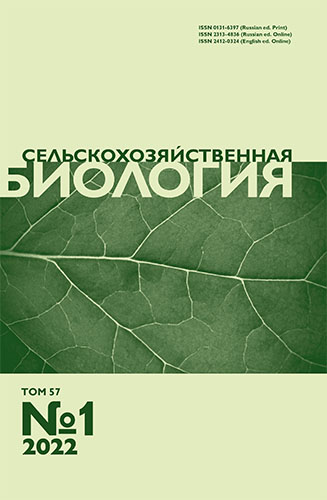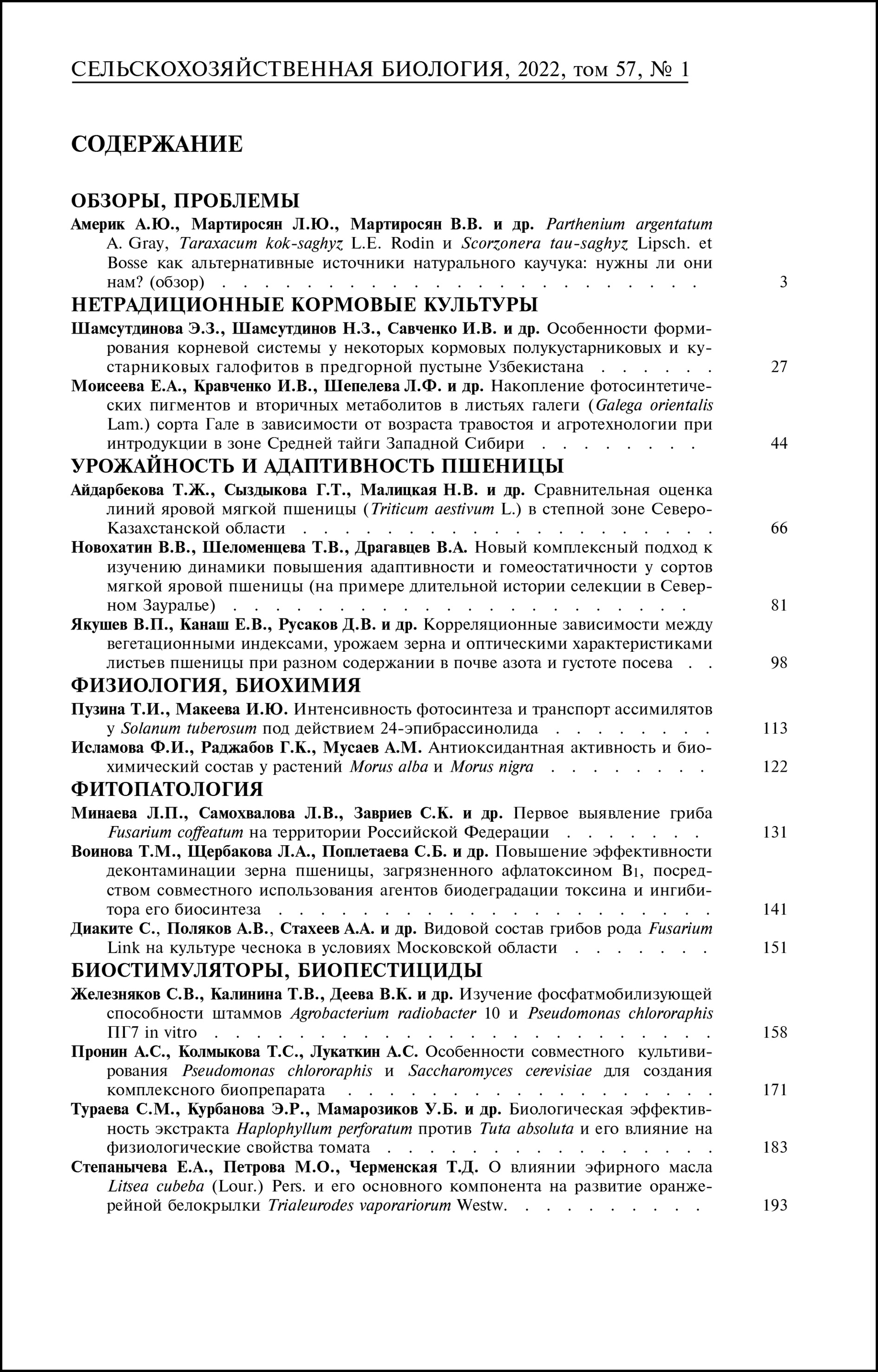doi: 10.15389/agrobiology.2022.1.193rus
УДК 632.7:632.937:632.951.2
О ВЛИЯНИИ ЭФИРНОГО МАСЛА Litsea cubeba (Lour.) Pers.
И ЕГО ОСНОВНОГО КОМПОНЕНТА НА РАЗВИТИЕ
ОРАНЖЕРЕЙНОЙ БЕЛОКРЫЛКИ Trialeurodes vaporariorum Westw.
Е.А. СТЕПАНЫЧЕВА, М.О. ПЕТРОВА, Т.Д. ЧЕРМЕНСКАЯ ✉
Оранжерейная белокрылкаTrialeurodes vaporariorum Westw. (Hemiptera, Aleyrodidae) наносит значительный экономический ущерб овощным и декоративным культурам. В связи с высоким потенциалом размножения фитофага и многократными химическими обработками, вызывающими возникновение резистентности к инсектицидам, требуются новые эффективные и экологически малоопасные средства защиты растений. Значительный интерес в этом плане представляют растительные эфирные масла. В настоящей работе впервые получены сведения об эффективности эфирного масла L. cubeba и цитраля в качестве фумигантов и репеллентов для контроля численности тепличной белокрылки. Целью нашей работы было изучение различных механизмов действия эфирного масла Litseacubeba и его основного компонента — цитраля на Trialeurodesvaporariorum. Культуру белокрылки разводили в лабораторных условиях на растениях фасоли (Phaséolus vulgaris L.) при температуре 24±1 °С и световом периоде 16 ч. Эфирное масло L. cubeba и цитраль были получены из Crop Research Institute (г. Прага, Чешская Республика). Для испытаний готовили 1 % растворы эфирного масла L. cubeba или цитраля посредством растворения 100 мкл вещества в 900 мкл этилового спирта с последующим добавлении 9 мл воды при перемешивании. Концентрации 0,5; 0,25 и 0,125 % получали методом последовательного разбавления водой. Перед началом экспериментов провели оценку фитотоксичности эфирного масла L. cubeba и цитраля. Затем изучали действие эфирного масла при обработке преимагинальных стадий вредителя на отрождение яиц и дальнейшее развитие личинок. Также оценивали влияние эфирного масла L. cubeba и цитраля на предпочтение T. vaporariorum растений для питания и откладки яиц при свободном выборе. При изучении фумигационного действия оценивали число живых, погибших особей и отложенных яиц. Данные экспериментов были проанализированы с помощью однофакторного дисперсионного анализа (one-way ANOVA), средние значения сравнивали по критерию Tukey’s HSD. При обработке яиц T. vaporariorum растворами эфирного масла L. cubeba в течение всего преимагинального периода развития ни одна из испытанных концентраций не влияла на жизненные показатели фитофага. Аналогичная ситуация была зарегистрирована и после обработки личинок. При содержании имаго белокрылки на обработанных маслом L. cubeba растениях отмечали статистически значимое (р ≤ 0,05) снижение числа отложенных яиц на 25 % по сравнению с контролем при концентрации масла 0,25 %. Летучие вещества масла при использовании в концентрации 0,25 % обладали репеллентным действием и потенциалом для снижения численности потомства. Индекс предпочтения составлял -18,7, а число отложенных яиц снижалось почти на 40 %. Наиболее выраженное действие масла на тепличную белокрылку наблюдалось при фумигации. МаслоL. cubeba(дозировки 9,0 и 6,0 мкл/л) вызывало гибель 90 % имаго и снижение числа яиц по сравнению с контролем соответственно на 98,2 и 93,8 %. Цитраль не проявил репеллентного действия, но его фумигационная активность не уступала таковой у эфирного масла. Максимально используемое количество цитраля (6,0 мкл/л) при таком способе воздействия приводило к смертности 85,9 % имаго и уменьшению числя яиц более чем на 90 %. Представленные данные доказывают перспективность масла L. cubeba в качестве фумиганта и репеллента в отношенииT. vaporariorumв условиях закрытого грунта.
Ключевые слова: эфиромасличные растения, цитраль, Trialeurodes vaporariorum, белокрылка, токсичность, фумигация, репеллентный эффект.
E.A. Stepanycheva, M.O. Petrova, T.D. Chermenskaya ✉
Trialeurodes vaporariorum Westw. (Hemiptera, Aleyrodidae) causes significant economic damage to vegetable and ornamental crops, due not only to direct phytophage feeding, but also to the transfer of viral plant diseases. In connection with the high potential for reproduction and repeated chemical treatments, leading to the emergence of resistance to various insecticides, it becomes necessary to search for new effective environmentally safe plant protection products. Plant essential oils are of considerable interest in this regard. In this work, for the first time, we obtained information about the effectiveness of Litsea cubeba essential oil and its main component, citral, as fumigants and repellents for controlling the number of greenhouse whiteflies. As the problem of reducing the insecticidal load is especially acute in greenhouses, the aim of our study was to examine mechanisms of action of L. cubeba essential oil and citral on T. vaporariorum — one of the most harmful phytophages for greenhouse crops. Obtaining information on the effectiveness of the tested samples will serve as the basis for the development of a new protective tactic against the greenhouse whitefly. The whiteflies were lab-reared on bean (Phaseolus vulgaris L.) plants at 24±1 °С and a 16 h light period. The essential oil of L. cubeba and citral were obtained from the Crop Research Institute (Prague, Czech Republic). For testing, 1 % solutions of L. cubeba essential oil or citral were prepared by dissolving 100 μl of the substance in 900 μl of ethanol, followed by the addition of 9 ml of water with stirring. Concentrations of 0.5, 0.25, and 0.125 % were obtained by sequential dilution with water. The phytotoxicity of L. cubeba essential oil and citral was pre-assessed. The pest preimaginal stages were treated to assess the effect of the essential oil on egg hatching and the larvae development. The influence of L. cubeba essential oil and citral on the choice of plants by T. vaporariorum for feeding and oviposition under free choice was also investigated. When studying the fumigation effect, the number of live, dead individuals and laid eggs was assessed. The experimental data were analyzed with one-way analysis of variance (one-way ANOVA), the mean values were compared using the Tukey’s HSD test. Differences between the means were considered significant at p ≤ 0.05. When the T. vaporariorum eggs were treated with solutions of L. cubeba essential oil, none of the tested concentrations affected the vital parameters of the phytophage during the entire preimaginal period of development. A similar pattern occurred after the treatment of larvae. The obtained results show the absence of both direct toxic effects and aftereffects during treatment at the embryonic and larval stages of whiteflies. When whitefly adults were kept on plants treated with 0.25 % concentration of L. cubeba oil, the number of laid eggs significantly decreases (by 25 % compared to the control). Oil volatiles at 0.25 % concentration had a repellent effect and reduced the offspring numbers. The preference index was -18.7, and the number of laid eggs decreased by almost 40 %. The fumigation effect of the L. cubeba oil on the greenhouse whitefly was most noticeable. L. cubeba oil (9.0 and 6.0 μl/l) caused the 90 % death of adults and a decrease in the number of eggs by 98.2 and 93.8 %, respectively, compared to control. Citral had no repellent effect but its fumigation activity was not inferior to that of essential oil. The maximum used citral concentration of 6.0 μl/l led to 85.9 % mortality of adults and a decrease in the number of eggs by more than 90 %. Our findings suggest prospects of the L. cubeba oil application as a fumigant and repellant aainst T. vaporariorum in greenhouses.
Keywords: essential oil plants, citral, Trialeurodes vaporariorum, whitefly, toxicity, fumigation, repellent effect.
1ФГБОУ ВО Мордовский государственный |
Поступила в редакцию |












